Table of Contents
Air Purifying Plants For Indoor Use
The air in our homes and offices is filled with toxic carbon-based molecules called volatile organic compounds (VOC). These particles have a low boiling point, and consequently, a high vapor pressure at regular room temperature. This results in the particles escaping from their solid and liquid forms into the atmosphere by virtue of a phenomenon called volatility.
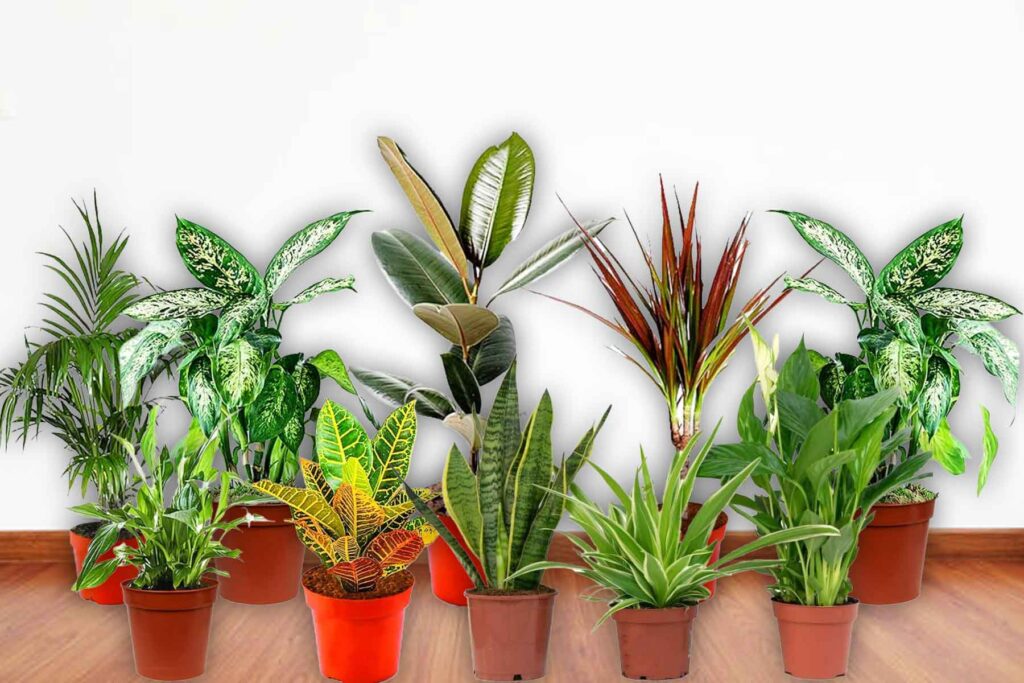
VOCs are emitted from common household products like cleaning supplies, plywood cabinetry, aerosol cans, paper towels, plastic bags, synthetic clothes, insect repellant sprays, glues, paints and personal care products. Common VOCs include formaldehyde, ammonia, benzene, toluene, xylene and tricholorethylene. They are highly detrimental to health and are known to cause headache, dizziness, nausea, irritation of the eyes, nose and throat, coughing, wheezing and sneezing.
Prolonged exposure to high amounts of VOCs can affect the lungs, heart, liver and kidney, and lead to chronic debilitating diseases.
Indoor air requires cleaning to keep it free of harmful chemicals. While there are several electronic devices specializing in indoor air purification, a good way to ensure the wholesomeness of your house air is by growing air purifying indoor plants. Air purifying indoor plants play a critical role in indoor air purification. They remove noxious pollutants from the air and make it suitable for human respiration.
The National Aeronautics and Space Administrtion (NASA) conducted a Clean Air Study in which it categorically stated that air purifying plants are a great way to combat indoor air pollution. It published a list of plants known for their air filtering quality, and charted out the chemicals they help remove from the air.
In the following paragraphs we have drawn up a list of the top 9 air purifying plants according to their air cleansing property. Here it is. Hope you find it useful.
The 9 Best Air Purifying Plants For Indoor Use :
1. Syngonium Pink Air Purifying Indoor Plant
One of the most effective air purifying plants for indoor use is the Green Pink Syngonium, also known as Nepthytis or Arrowhead plant. Syngonium is a genus of flowering plants found in tropical rainforests around the world. It is native to Mexico, Central and South America and South Asia.
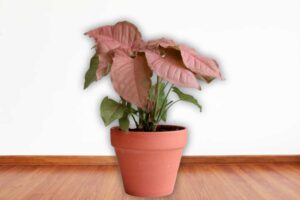
The plant has a woody vine and grows on the surface of other plants for mechanical support. It can climb tree trunks up to 20 meters with leaves of different shapes at different heights. Leaves of mature plants have more lobes than the young. The reason for this is most Syngoniums grown as indoor houseplants are juvenile plants in their initial foliage stages, and hence, have fewer lobes in their leaves than adult plants. Pink Syngonium is known for its air-cleaning properties.
It is an excellent plant for combating air pollution in homes and offices. It is easy to care for and requires very little maintenance.
The plant needs to be watered every alternate day with appropriate regulation depending on the season. Summers you may water it more and winters less. Take care not to over water the plant. Over watering is one of the commonest causes of house plant death.
Syngonium is a sensitive plant. It must not be kept in direct sunlight as it may cause the leaves to wilt. Ideally, about 3 to 4 hours of indirect sunlight everyday is sufficient for healthy growth. The plant thrives in humid conditions. Therefore, misting the leaves can be a good idea.
The plant can withstand temperatures of up to 45ᵒC. Old and yellowing leaves must be pruned from time to time. Neglecting to remove dried leaves can lead to fungal disease. The plant comes in a square brown ceramic pot measuring 9’ x 10’ x 10’ and is made from good quality clay.
The plant can be a great addition to your living room or office cubicle. The leaves have varying shades of pink and green which goes very well with modern home and office interiors. It looks good on office tables, media consoles, bookshelves and kitchen counters.
2. Golden Pothose Air Purifying Plant
The next indoor plant known for its air purifying nature is the Golden Pothose, also commonly known as Money Plant or Silver Vine. Its scientific name is Epipremnum aureum and it belongs to the family of Araceae. It is a species of flowering plant with white, yellow, dark green and light green variegation in leaves.
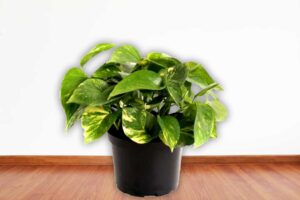
Variegation is the property by which leaves develop different colors, often displaying alternating shades in a single leaf. The Golden Pothose is an extremely hardy plant and can survive in temperate, tropical and sub-tropical environments. That is why it is also sometimes called the Devil’s Vine. It grows freely in forests around the world and is also grown domestically as ornamental houseplants.
The plant needs diffused sunlight and is intolerant to harsh direct sunlight. Our suggestion would be to place it in a cool dry place where it can receive around 3 to 4 hours of mild indirect sunlight every day. Prolonged exposure to direct sunlight can cause wilting and dark spots in leaves.
The Golden Pothose plant can withstand intermittent watering. It does not require daily watering; just once or twice a week is fine. The plant can scale tree trunks and walls up to a great height. Leaf size varies according to height and age of the vine. Older plants have larger leaves and thicker stems while juvenile plants have smaller leaves and thinner stems. The leaves of the Golden Pothose are heart-shaped and alternate.
The vines develop aerial roots that cling to surfaces for support. The greatest advantage of having a potted Golden Pothose in your living room is that it purifies the indoor air and keeps it free of harmful pollutants.
Golden Pothose removes gaseous impurities like formaldehyde, benzene and xylene from the air. These pollutants are released into the air by household products like cleaning supplies, paints, glues, personal care products and plywood cabinetry. By removing these substances, the plant makes the air healthier for breathing. The plant comes in a blue and white ceramic pot with imported coco peat.
3. Peace Lily Indoor Plant
The Peace Lily is an attractive indoor house plant. It is used as a decorative plant for enhancing the aesthetics of offices and homes. It belongs to the genus Spathiphyllum which has around 40 species of monocotyledonous flowering plants.
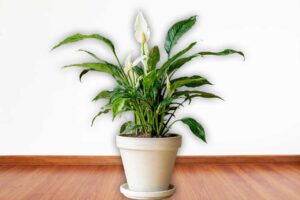
The plant is evergreen and herbaceous in nature. It has large leaves measuring 3 to 25 cm in breadth and 12 to 65 cm in length. The flowers grow in a spadix. A spadix is a fleshy stem with tiny flowers occurring in a spike inflorescence. The spadix of the Peace Lily is surrounded by a white, yellow or green bract.
A bract, also called spathe, is a specialized leaf that grows around a flower or cluster of flowers. The spathe of the Peace Lily measures around 10 to 30 cm in length and is mostly white, yellow or light green in color. It is very pretty and lends the plant its distinctive look. The Spathiphyllum is known for its air purifying qualities.
The NASA Clean Air Study has declared the Peace Lily to be an excellent air purifying plant. It is one of the top 10 air filtering plants mentioned in the study. According to the NASA report, Spathiphyllum removes formaldehyde, benzene, trichloroethylene, xylene, toluene and ammonia. These are various kinds of volatile organic compounds (VOCs) released into the air by household goods like cleaning supplies, pressed wood furniture, aerosol cans and paints.
VOCs cause respiratory issues in humans and induce coughing, wheezing, nausea, headaches and sneezing. Thankfully, there are certain indoor plants that can help fight air pollution and the Peace Lily is one of them. The plant requires very little maintenance. It needs to be watered sparingly every two or three days. It thrives in diffused sunlight and must be kept away from direct sunlight. Living rooms, kitchens and studies are the best places to suit it.
The Peace Lily plant comes in durable plastic pot. It also includes 5 grams of Basacote (19:19:19) fertilizer. Ideal temperature for the plant is 25ᵒC to 35ᵒC, although it can survive a minimum temperature of 15ᵒC. Misting the leaves can be a good idea. It will provide the required humidity for good overall growth.
4. Spider plant
The next air purifying indoor plant we would like you to check out is the Spider plant. Its scientific name is Chlorophytum comosum and it is commonly known as Spider plant. Other names of the plant include Hanging Spider plant, Ribbon plant and Airplane plant.
The Spider plant is a perennial flowering plant with long and slender variegated leaves with varying shades of white and green. It grows to a maximum height of about 60 cm with leaves measuring 20 to 45 cm in length from base to tip and 6 to 25 mm in width.
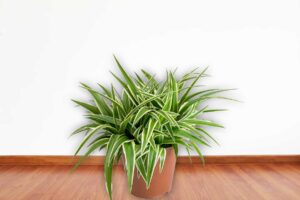
The roots are tuberous and fleshy. Tiny green and white flowers grow on long thin downward-bending stalks. These stalks, also called inflorescences, bear small plantlets that grow downwards and strike out adventitious roots upon coming in contact with the soil.
A Hanging Spider plant with multiple plantlets is a magnificent sight to behold and makes for an attractive hanging houseplant. It is perfect for indoor spaces and improves the décor of any room it is placed in. The Spider plant is nurtured for its air filtering properties.
According to the NASA Clean Air Study, it ranked among the top 10 air purifying houseplants. It can effectively remove formaldehyde, xylene and toluene which are toxic air pollutants found in most households. These substances escape from everyday home products like deodorants, perfumes, cosmetics, adhesives, paints, surface cleaners and plywood furniture. They interfere with the respiratory and nervous system, and cause irritation of the eyes, nose and throat.
The plant additionally removes atmospheric carbon monoxide which is an extremely poisonous gas. Studies have shown that 70 Spider plants are enough to neutralize domestically released formaldehyde from a 1700ft2 energy-efficient room if each plant occupies a 3.8 liter pot.
The Spider plant by Rolling Nature comes in a white ceramic pot. It needs direct sunlight but can also proliferate in partially shaded places which receive a few hours of direct sun daily. The plant needs to be watered regularly without being over watered.
5. Boston Fern
Among air cleaning oxygen producing plants, the Boston Fern is a great option. Its scientific name is Nephrolepis exaltata and it is also known as Sword Fern and Fishbone Fern. The plant thrives in humid places like swamps and forest beds, and is also found near waterfalls, springs and streams.
The fronds of the Boston fern are 50 to 250 cm long and 6 to 15 cm wide. Each frond consists of a slender woody midrib with alternating leaflets (2 to 8 cm long) on either side of it. The fronds of the plant arch gracefully bending downwards. They form a dense crown of leafy growth ideal for living rooms and office corners.
The Boston fern can enhance the appearance of any room or porch. It is easy to maintain and can survive in all kinds of sunlight and soil conditions. Although it prefers direct sunlight, it can also exist in partially shaded environments. The plant loves humidity and thrives in soil that’s damp and fertile.
However, it is surprisingly resistant to drought and can survive long months without water. During winter due to frost, the plant may appear to be dead, but come spring and it blooms back to life. This makes the fern one of the hardiest houseplants and the easiest to grow. The most important quality of the Boston Fern is its air cleaning ability.
According to a report published by the NASA Clean Air Study, the Boston Fern can eliminate formaldehyde, xylene and toluene. These substances escape as gaseous molecules from household goods like plywood furniture and cabinetry, aerosol cans, paints and personal care products. They are classified as volatile organic compounds. They pollute the air in homes and cause health issues in humans. The Boston fern is not toxic to cats and dogs.
The plant is potted in a good quality plastic pot and is supplied with good packaging.
6. Tree Ivy Plant
The Tree Ivy plant, also known as Aralia Ivy, is a good air purifying plant. Its scientific name is ×Fatshedera lizei and it is an inter-generic hybrid flowering plant meaning it is a hybrid of plants from two different genera. The × symbol in front of the name signifies the plant’s hybrid status. It was created by crossing Fatsia japonica and Hedera helix.
The Tree Ivy has five-lobed leaves like the Hedera and takes after the shrubby nature of the Fatsia. It can grow to a height of 1.2 meters, beyond which it needs support to stay erect, else it can start to droop. If supported by a trellis or pole, the plant can grow up to a height of 3 to 4 meters.
The leaves of the Tree Ivy are 7 to 25 cm broad and have white, yellow and green variegation. The plant produces small yellowish-white flowers measuring 4 to 6 inches in diameter.
The Tree Ivy is known for its air-filtering quality. It rids the air of harmful air contaminants and makes it cleaner and safer for respiration. It is best used as an indoor plant for removing toxic air pollutants from homes and offices. The plant is great to look at and enhances the appearance of any room it is placed in. It can survive in dimly lit places as well as in bright sunlight.
However, a semi-shaded spot with enough moisture is best suited for its all-round balanced growth. Excessive exposure to scorching hot sun can cause wilting and bleaching of leaves.
The Tree Ivy needs medium watering and humidity. It does not grow well in soil that is too soggy or constantly waterlogged. The plant can also be grown outdoors as a garden plant. The Tree Ivy is a winter-hardy plant and can withstand sub-zero temperatures down to -15ᵒC. This makes the plant an ideal houseplant for colder climates. The plant is sold in a pot.
7. Drunken Gnome Air Plant
The next plant on our list of best indoor oxygen producing plants is the Drunken Gnome Air plant. It is a small houseplant used in homes and offices to clean indoor air. It belongs to the genus Tillandsia and is a perennial flowering plant. In diverse environments like high-altitude tundra regions, equatorial rainforests, swamps and rocky and arid places it can grow.
Most plants in the genus Tillandsia are called Airplants owing to their epiphytic or aerophytic nature. An epiphyte is a plant that grows on another plant and depends on it for support. It however manufactures its own food by drawing nutrients and water from the air, rain and debris surrounding it. An aerophyte is a plant that grows on shifting soil and has a reduced root system.
The Drunken Gnome Air plant is a fast-growing airplant. It hardly requires any soil or earth and can subsist on driftwood, tree trunks and branches. For use as an indoor houseplant, it can be grown in a glass orb terranium or placed in a hanging airplant holder or sea shell.
The leaves of the plant are thin and elongated with pointed tips. The inflorescences or flowers are brightly colored with vibrant shades of pink, purple, orange, red and yellow. They grow on tall stalks and are mostly pollinated by moths and humming birds.
The Drunken Gnome Air plant is best suited for humid environments and needs to be watered once to thrice a week. It needs indirect sunlight and is ideal for living rooms conditions. Typically, plants with thick silver-dusted leaves need more sunlight than plants with thinner leaves.
The Drunken Gnome Air plant removes impurities from the air. They help you breathe easy and healthy with a extremely low-maintenance and an elegant look. They are a great way to decorate your office desk and home theatre console. It may be a great gift for friends and family.
8. Fiddle-Leaf Fig Plant
The next amazing air filtering plant on our list is the Fiddle-Leaf Fig Plant. Its scientific name is Ficus lyrata and it is a flowering plant belonging to the fig and mulberry family Moraceae. It is found naturally in lowland tropical rainforests in Africa. It can also be nurtured in tropical, subtropical and temperate parts of the world under proper care and maintenance. In temperate regions, however, the plant may fail to fruit or flower due to the extreme climatic conditions.
The Fiddle-Leaf Fig plant is an ornamental plant grown both outdoors and indoors. Outdoors it grows up to a height of 50 feet and flourishes as a free-standing tree. Indoors, the tree can be groomed to stay shorter, growing out of flower pots as a corner plant in living rooms and offices.
The leaves of the Fiddle-Leaf Fig plant have a leathery texture with a shiny glaze. They are broader at the apex and narrower at the middle with distinct veins and wavy margins. They are approximately 18 inches long and 12 inches wide.
In tropical rainforests, the plant bears fruits in the form of small green figs measuring 3 cm in diameter. The Fiddle-Leaf Fig is an effective air filtering plant. It removes TVOCs from the house air and makes it safe for inhalation. TVOCs cause headache, nausea, coughing, wheezing, and irritation of the throat and nasal passages.
The plant needs to be watered once or twice a week. In case you pour too much water, make sure to drain out the excess amount. The plant loves bright filtered light and can be placed near a widow shielded by a thin translucent curtain. Continuous exposure to direct sunlight can cause the leaves to wilt. Therefore, make sure it gets ample amount of mild sunlight throughout the day, but avoid direct harsh sunlight.
The plant can withstand low temperatures down to 10ᵒC. The Fiddle-Leaf Fig is a superb houseplant for flanking couches and recliners. It can also be placed in washrooms and kitchens to compliment the modern décor. Being a large-leafed plant, it is best stood on the floor next to a sofa, cabinet or desk.
9. Purple Heart Plant
The last entry to make our list of top air purifying indoor plants is the Purple Heart Plant. Its scientific name is Tradescantia pallida and it is a species of spiderwort, commonly also known as Wandering Jew and Purple Queen plant. It is indigenous to eastern Mexico and is abundant in the Gulf Coast region of the country. It also grows in other parts of the world with tropical and sub-tropical environments.
The Purple Heart plant is an evergreen perennial flowering plant with purple, green, red and white leaves. The colors occur in varying shades and patterns with variegation. The leaves are long and slender with pointed apexes. The flowers are sterile and are pink, purple and white in color. The stems are fleshy and erect for a few inches off the ground. Beyond a certain height, it starts to droop downwards and grows as a creeper.
Under moderate frost conditions, the shoot dies off leaving behind the roots that sprout back in spring or summer when the snow thaws. The Purple Heart is a popular house plant. It is groomed as a hanging plant, ground-cover and border plant in landscape gardens. It can proliferate from cuttings which makes it an easy plant to proliferate.
The Purple Heart is one of the best air purifying indoor plants used in modern homes. It is an oxygen producing plant which removes harmful VOCs from the atmosphere in homes and offices.
VOCs are a class of toxic carbon-based particles that escape from household products like paper towels, synthetic clothes, cleaning supplies, adhesives, paints, deodorants, plastic bags and plywood furniture. These particles cause health issues in humans including headache, dizziness, coughing, sore throat and irritation of the nose and esophagus.
The Purple Heart plant is surprisingly easy to maintain. It does not require frequent watering. That’s okay, only once or twice a week. You can water it when you notice the top soil becoming dry. The plant does not require direct sunlight and is tolerant to shade. This makes it perfect for indoor use as an ornamental plant.
You can plant the Purple Heart in a ceramic pot and place it a corner of your living room or hang it from a hook in the porch. The plant is delivered in properly packaged condition in a 4-inch pot.
Check the level of air pollution and particulate matter with these best in class Air Quality Monitor.
Bamboo charcoal bags are very effective way for natural air purification.

